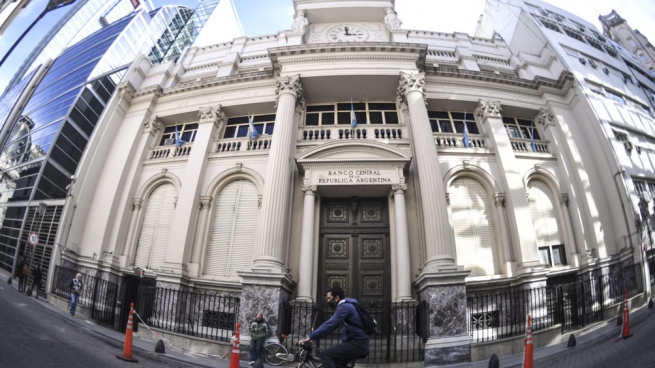The decision of the Central Bank (BCRA) to buy Treasury bonds in the last month for about $1 billion was necessary to maintain its price and protect the debt market in pesos, agreed analysts consulted by Télam, although they agreed that it is about a “short-term” measure with possible inflationary, foreign exchange and balance sheet consequences.
This week, Both the Minister of Economy, Silvina Batakis, and the President of the BCRA, Miguel Pesceagreed on the importance of supporting the local debt market, as a key part of the financing scheme, and defended the position of discharging funds and private investors who sold Treasury bonds.
“That the Central Bank can face (this situation), speaks well of the Central Bank,” Batakis claimed in an interview this week.
Along the same lines, he assured that monetary and financial policy is being “articulated hour by hour” and valued that “in the economy situations of tension are generated but in these days we saw that the Central Bank can handle the situation”.
In turn, Pesce reaffirmed days ago in a meeting with banks the BCRA’s commitment to be “standing on the yield curve of Treasury bills and bonds to sustain the value of public securities.”
According to a report by Quinquela Fondos, the BCRA had bought more than $650,000 million until the end of June and that in the first days of July it would have added more than $350,000 million in Treasury securities.
This was due to a bailout process in the mutual fund industry that generated a sharp drop in the parity of bonds in pesos at the beginning of June and, to cut that dynamic, the BCRA decided to intervene by buying the bonds, offering liquidity and allowing the debt yield curve to adjust.
“I think it is positive and necessary for the Central Bank to go out and put a floor on bond prices, but of course it is a very short-term measure and eventually they would have to give guidelines on how to follow from now on, to reduce the context of uncertainty,” he told Télam Javier Casabal, fixed income strategist at Adcap Grupo Financiero.
At the moment, most of the issue to buy titles was sterilized by the Central -according to official data, Until July 5, the stock of Leliq and passes increased by $950,000 million– to prevent excess pesos from circulating in the economy and putting pressure on prices or the exchange rate gap.
For Casabal, this means that “the final effect is to replace one creditor (the private holders) with another (the Central Bank)” but that the “concern that is generated is for the Balance of the Central Bank and the support of the currency”.
“At the time, there was concern that the level of remunerated liabilities had already reached 160% of the Monetary Base, but when considering all this in real terms, we see that the level is still well below 2018 and the level remains relatively stable given that these liabilities are liquidated with inflation,” he added.
In any case, he pointed out that this “only works for the very short term” since “to the extent that genuine demand does not appear in the secondary market, the prospects for the next tender at the end of the month are not too encouraging” and that ” signals will eventually have to be sent about the deficit to restore market confidence.”
For Juan Pablo Albornoz, economic analyst at Ecolatina“the positive aspect of this measure is that it made it possible to sustain prices and try to normalize a convulsed market so that, in some way, the market buys that vision. The crisis was transitory.”
Even so, he pointed out that if the intervention continues it would be “a bad sign”, since the prices would not reflect the expectations of the market, but rather “it is the public sector itself that comes out to support the Treasury debt securities” and that this would make it difficult anticipate how the Treasury might fare in future auctions.
“We are seeing the most immediate and negative consequence of the Central Bank’s policy with the rise in financial dollars,” said Albornoz.
For its part, the director of Anker Latin America, Martin Vauntier, He pointed out that “the intervention of the Central Bank was a way of managing, in the short term, and of trying to put a floor on the prices of bonds in pesos.”
“In some way, it also reflected the government’s willingness to pay this debt even at the cost of issuing money, with all the costs that this has,” he told Télam, since it implies that “those pesos later have to be sterilized and, at the same time, At the end of the day, it ends up with a larger and more deteriorated balance sheet, with more government titles in assets and with more pesos or more Leliq in liabilities”.
“I think it’s a very short-term management mechanism, but well, it has costs in terms of deepening the deterioration of the BCRA’s balance sheet, especially if it stays on the scale we’ve seen in recent weeks,” said Vauntier, who insisted on the need to “anchor expectations through an economic program” that is “very solid and credible for the market”.
For this, he pointed out the importance of “rapid fiscal consolidation” and “that it be backed by politics”, so that it provides guarantees that “it will be sustained over time”. “To the extent that these two conditions are not present, the Central Bank’s intervention is a measure, like so many others, that generates costs and distortions and that only works in the very short term,” concluded Vauntier.
President Alberto Fernández is scheduled to meet this Sunday with Minister Batakis, who already confirmed his economic cabinetto analyze measures on price increases and other issues regarding the economic agenda for the coming days, in which announcements on fiscal, monetary and financial policy could be made.








